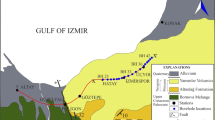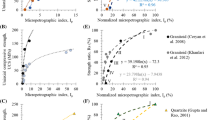Abstract
The purpose of this case study is to introduce a new weathering classification system of rocks based on the engineering properties. Even though several authors have suggested different classification systems worldwide, limited research has been conducted to propose a classification system that includes more than two engineering properties. To suggest a better system to classify the rock, four rock types belonging to different weathering grades were tested (around 150 tests) to determine the point load index (Is (50)), slake durability index (Id2), density, mineralogy, and microstructure. The mineralogy and microstructure of fresh and weathered samples were observed by conducting X-ray diffraction (XRD) and scanning electron microscopy (SEM) tests. The Is (50), Id2, and density appeared to decrease as weathering grade increased, albeit with relatively high correlation coefficient. The statistical analysis, including multiple linear regression, was used to identify the correlations between those parameters. The increase in clay mineral content, microcracks, and pore density was observed in the weathered samples when comparing to fresh samples. The obtained test results were used to develop engineering classification systems (ECS) which provide a quick estimation of engineering properties of the weathered rock. The proposed ECS are developed using the relevant published literature. Therefore, these classifications can be used generally to predict the engineering properties of basalt, argillite, sandstone, and greywacke.








Similar content being viewed by others
Data availability
Data available upon request.
References
Ahmed L, Akram MS (2022) Durability based classification and characterization of the rocks of the Sub-Himalayas, Pakistan. Geotech Geol Eng 40:4069–4081
Baczynski NR (2001) Intact rock strength of Neranleigh-Fernvale strata. Australian Geomechanics, Volume on Geotechnical Engineering and Engineering Geology of Brisbane and SE Queensland, IEAust 36(3):9–15
Bertuzzi R, Douglas K, Mostyn G (2016) Comparison of quantified and chart GSI for four rock masses. Eng Geol 202:24–35
Broch E, Franklin JA (1972) The point-load strength test. Int J Rock Mech Min Sci Geomech Abstr 9(6):669–676
Ceryan S (2012) Weathering indices for assessment of weathering effect and classification of weathered rocks: a case study from NE Turkey. Retrieved from http://www.intechopen.com/books/earth-sciences
Ceryan S, Tudes S, Ceryan N (2008) A new quantitative weathering classification for igneous rocks. Environ Geol 55(6):1319–1336
Dhakal G, Yoneda T, Kato M, Kaneko K (2002) Slake durability and mineralogical properties of some pyroclastic and sedimentary rocks. Eng Geol 65(1):31–45
Diamantis K, Gartzos E, Migiros G (2009) Study on uniaxial compressive strength, point load strength index, dynamic and physical properties of serpentinites from Central Greece: test results and empirical relations. Eng Geol 108(3):199–207
Duggan MB, Mason DR (1978) Stratigraphy of the Lamington volcanics in far northeastern New South Wales. J Geol Soc Aust 25(1–2):65–73
Erguler ZA, Ulusay R (2009) Assessment of physical disintegration characteristics of clay-bearing rocks: disintegration index test and a new durability classification chart. Eng Geol 105(1–2):11–19
Gratchev I, Pathiranagei SV, Kim DH (2019) Strength properties of fresh and weathered rocks subjected to wetting–drying cycles. Geomech Geophys Geo 5(3):211–221
Gupta A, Rao K (1998) Index properties of weathered rocks: inter-relationships and applicability. Bull Eng Geol Environ 57(2):161–172
Gupta A, Rao KS (2000) Weathering effects on the strength and deformational behaviour of crystalline rocks under uniaxial compression state. Eng Geol 56(3):257–274
Heidari M, Momeni A, Naseri F (2013) New weathering classifications for granitic rocks based on geomechanical parameters. Eng Geol 166:65–73
Hodder APW, Hetherington JR (1991) A quantitative study of the weathering of greywacke. Eng Geol 31:353–368
ISRM (1981) Basic geotechnical description of rock masses. Int J Rock Mech Min Sci Geomech Abstr 18:85–110
Kim DH, Gratchev I, Balasubramaniam A (2013) Determination of joint roughness coefficient (JRC) for slope stability analysis: a case study from the Gold Coast area. Australia Landslides 10(5):657–664
Kim DH, Gratchev I, Balasubramaniam A (2015) A photogrammetric approach for stability analysis of weathered rock slopes. Geotech Geol Eng 33(3):443–454
Leão MF, Barroso EV, Polivanov H, Marques EAG, do Amaral Vargas E, (2017) Weathering of metapelites from the Quadrilátero Ferrífero mineral province, southeastern Brazil. Bull Eng Geol Environ 76(3):1167–1182
Lee S, De Freitas M (1988) Quantitative definition of highly weathered granite using the slake durability test. Geotechnique 38(4):635–640
Look BG (2004) Rock strength at the coring interface. Aust Geomech 39(2):105–113
Look BG, Griffiths SG (2001) An engineering assessment of the strength and deformation properties of Brisbane rocks. Aust Geomech 36(3):17–30
Makumbi MN, Jackson ML (1977) Weathering of Karroo argillite under equatorial conditions. Geoderma 19(3):181–197
McElroy CT (1969) VI The Clarence-Moreton Basin in New South Wales. J Geol Soc Aust 16(1):457–479
Mohamad ET, Jahed Armaghani D, Momeni E et al (2015) Prediction of the unconfined compressive strength of soft rocks: a PSO-based ANN approach. Bull Eng Geol Environ 74, 745–757. https://doi.org/10.1007/s10064-014-0638-0
Momeni A, Hashemi S, Khanlari G, Heidari M (2017) The effect of weathering on durability and deformability properties of granitoid rocks. Bull Eng Geol Environ 76(3):1037–1049
Momeni A, Khanlari G, Heidari M, Sepahi A, Bazvand E (2015) New engineering geological weathering classifications for granitoid rocks. Eng Geol 185:43–51
Shokouhi A, Gratchev I, Kim DH (2013) Rock slope stability problems in Gold Coast area. Australia Int J Geomate 4(1):501–504
Standards Australia (2005) AS 4133.2.1.2–2005 Methods of testing rocks for engineering purposes-rock porosity and density. Retrieved from http://www.saiglobal.com
Standards Australia (2005) AS 4133.3.4–2005 Methods of testing rocks for engineering purposes. Method 3.4: Rock swelling and slake durability tests—determination of the slake durability index of rock samples. Retrieved from http://www.saiglobal.com.
Standards Australia (2007) AS 4133.4.1–2007 Method 4.1: Rock strength tests—determination of point load strength index. Retrieved from http://www.saiglobal.com
Tating F, Hack R, Jetten V (2013) Engineering aspects and time effects of rapid deterioration of sandstone in the tropical environment of Sabah, Malaysia. Eng Geol 159:20–30
Topal T (2002) Quantification of weathering depths in slightly weathered tuffs. Environ Geol 42(6):632–641
Tugrul A (2004) The effect of weathering on pore geometry and compressive strength of selected rock types from Turkey. Eng Geol 75:215–227
Udagedara D, Oguchi C, Gunatilake A (2017) Combination of chemical indices and physical properties in the assessment of weathering grades of sillimanite-garnet gneiss in tropical environment. Bull Eng Geol Environ 76(1):145–157
Vicente MA (1983) Clay mineralogy as the key factor in weathering of ‘arenisca dorada’ (golden sandstone) of Salamanca. Spain Clay Miner 18(2):215–217
Wells AT, O’Brien PE (1994) Lithostratigraphic framework of the Clarence-Moreton Basin. Bull Bureau Miner Res Aus 241:4–47
Whitlow R (2000) The Geology of the Gold Coast Region (pp. 1–47). Gold Coast
Wilkinson JFG (1968) The magmatic affinities of some volcanic rocks from the Tweed Shield Volcano, SE Queensland—NE New South Wales. Geol Mag 105(3):275–289
Willmott WF (1981) Slope stability and its constraints on closer settlement on Tamborine Mountain. Southeast Queensland Record 1981(14):1–48
Willmott WF (1983) Slope Stability and its constraints on closer settlement in the Canungra-Beechmont-Numinbah area, Southeast Queensland. Geological Survey of Queensland Record 1983(64):1–41
Willmott W, Hayne M (2001) Slope stability and its constraints on closer settlement — Springbrook plateau and upper Tallebudgera and Currumbin Valleys, Southeast Queensland. Queensland Geological Record 2001/1
Willmott W, Monteith S (1999) Rocks and landscapes of the Gold Coast hinterland: geology and excursions in the Gold Coast and Albert and Beaudesert Shires. Geological Society of Australia, Queensland Division
Author information
Authors and Affiliations
Corresponding author
Rights and permissions
Springer Nature or its licensor (e.g. a society or other partner) holds exclusive rights to this article under a publishing agreement with the author(s) or other rightsholder(s); author self-archiving of the accepted manuscript version of this article is solely governed by the terms of such publishing agreement and applicable law.
About this article
Cite this article
Vidana Pathiranagei, S., Gratchev, I., Cui, C. et al. New weathering classification system of rocks based on the engineering properties. Bull Eng Geol Environ 82, 60 (2023). https://doi.org/10.1007/s10064-023-03071-0
Received:
Accepted:
Published:
DOI: https://doi.org/10.1007/s10064-023-03071-0




